module 8
1. homeostasis: how is an organism’s internal environment maintained in response to a changing external environment?
1.1
NEGATIVE FEEDBACK
homeostasis: the proccess by which organisms maintain a relatively stable internal environment, especially for optimum enzyme function
tolerance limits: variables in internal environment (temperature, glucose) are maintained within a narrow range eg. 30-45 degrees for body temperature and has an ideal value known as the set point 37 degrees
1.2
ADAPTATIONS
adaptation: any inherited characteristic, process, or behaviour that aids an organism’s survival in a particular habitat. arise due to natural selection
ectothermic: body temperature changes with ambient temperature/metabolism generate little heat eg. reptiles, amphibians (water holding frog)
endothermic: body temperature remains relatively constant. Maintenance requires complex metabolic processes and therefore more food eg. mammals and birds
behavioural: the activities and behaviours of the organism eg. red kangaroo position so tail is in sun, bilby come out at night to avoid heat/predators.
structural: the physical characteristics of the organism eg. blubber in the Australian fur seal, SA:V of Äfrican elephant ears
physiological: the processes carried out by the structure/functions within the body eg. evaporative cooling, torpor by wombat (body temperature drops, metabolism, heart rate and respiratory rate decrease, reduced response to external stimuli
COORDINATION
Coordinating systems of the body work to maintain body temperature. The nervous & endocrine systems coordinate and provide pathways of communication for negative feedback process
Nervous System = neural pathways
very fast, up to 100m/s
CNS: brain & spinal cord. transmits messages to and from the brain and controls spinal reflexes
PNS: branching network of nerves, all enter/leave CNS eg. sensory nerves (arise from internal/external sensory receptors carry to CNS, interneurons carry impulses from sensory to motor neurons, motor nerves carry from CNS to effectors = muscles (somatic or autonomic)
Nervous Control:
Stimulus: a change occurs in the environment (internal/external) → Receptor: sensory receptors detect the stimulus and convert into electrochemical impulses that are directed to the CNS → Control centre: the brain determines the response. different parts of brain = different functions eg. hypothalamus maintain temperature → Effectors: motor neurons carry impulses from the spinal cord to effectors eg. muscles, glands, organs → Response: muscle/gland responds accordingly
Reflex: bypass brain
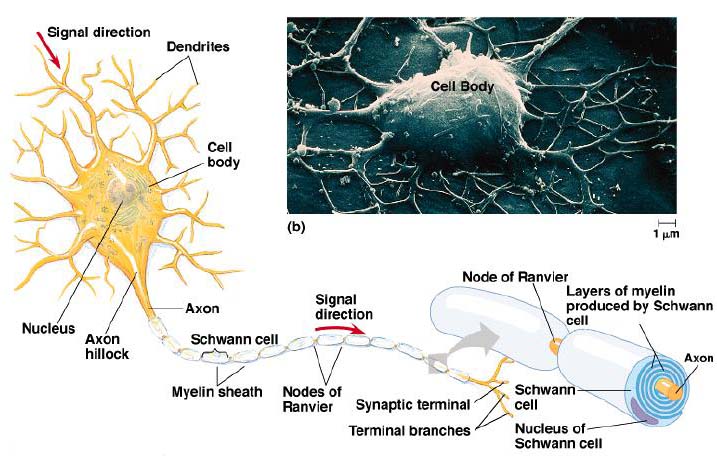 Nerve Structure: cell body (similar to other cell body), dendrites(receive signals from other neurons and carry to cell body), axon (carries messages away from cell body)
Nerve Structure: cell body (similar to other cell body), dendrites(receive signals from other neurons and carry to cell body), axon (carries messages away from cell body)myelinated fibres: white matter in CNS, unmylenated fibres &cell body: grey matter
Synapse: space between axon of one neuron and dendrite/cell body of next
electrical synapse: action potential moves directly from one neuron to the next
chemical synapse: impulse reaches end of axon, release chemicals (neurotransmitters) that travel to next neuron
stimulus causes Na+ channels to open, potassium pumps to close. Na rush in, increase voltage, may reach threshold
repolarisation: Na+ channels close, K+ open, inside of cell more negative
hyperpolarisation: K+ channels close relatively slowly, inside of cell temporarily negative
resting state: Na/K pumps open and restore resting potential
action potential: change in electrical potential of the cell membrane of axon, caused by electrochemical impulse
Resting Membrane Potential: -70mV as there are more Na+ outside the cell
Endocrine System
glands & hormones
long-lasting but relatively slow
hormones: chemical messengers that are transported by the bloodstream/extracellular fluids that change cell behaviour to maintain homeostasis. reach cell → bind to receptors → trigger response
pituitary gland: releases hormones (often on direction of hypothalamus) to regulate other glands
thyroid & parathyroid: release thyroxine, regulate body temp and blood calcium
adrenal: on top of kidneys, secrete cortisol (stress & conversion of carbohydrates)
pancreas: insulin & glucagon
hypothalamus: links nervous & endocrine system. sorts sensory information and produces numerous hormones.
Plants
only use hormones
auxins (growth, bending towards light), cytokinins (cell division, seeds etc), gibberellins, abscisc acid (inhibit germination), ethylene (ripening and aging)
Water Balance in Plants
opening & closing of stomata. Turgid = open. Thick, waxy cuticles, sunken stomata, succulent leaves (storage), deep roots below water table, shallow roots to absorb surface moisture
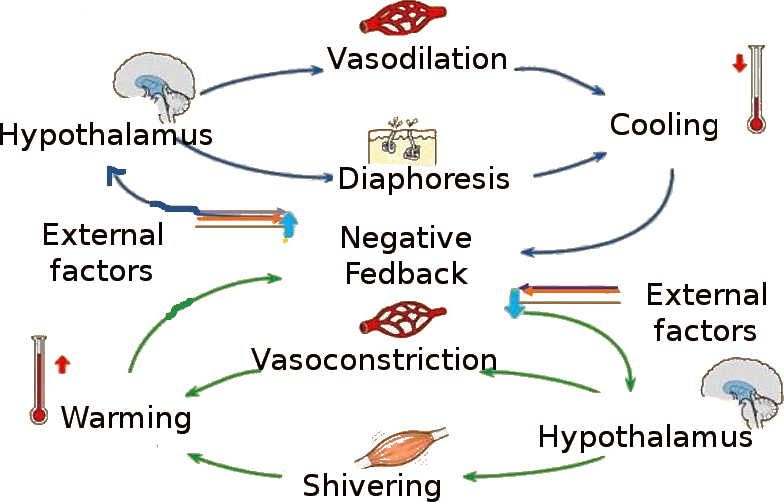

2. cause and effects: do non-infectious diseases cause more deaths than infectious diseases?
2.1
Non-infectious diseases: not caused by pathogens and aren’t transmittable from one individual to another
Categories
Genetic Disease: mutations that occur in germ-line cells that affect whole zygote eg. Down’s Syndrome. point mutation/chromosomal mutation (incorrect number of chromosomes)
Diseases Caused by Environmental Exposure: Factors in the environment have potential to cause disease eg. poor water quality, availability, and sanitation, vector-borne diseases, poor ambient and indoor air quality, toxic substances and environmental change.
Lifestyle: eg tobacco, drugs, alcohol can cause cancer, liver damage and mental health issues
Physical: eg. UV exposure and loud noises cause skin cancer and deafness
Chemical: Asbestos (lung disease), heavy metals. Disease depends on type/length of chemical exposure
Cancer: Normal cell growth/regulatory genes disturbed leading to uncontrolled cell replication and a tumour. Can be caused by environmental exposure. Benign cancer cells don’t spread (sarcoma/connective tissue, lymphoma/lymphatic tissue), malignant do (invade surrounding tissue, metastasis occurs, new blood vessels must develop).
Nutritional Disease: caused by lack of balance and correct nutrients.
undernutrition: insufficient intake of quality/quantity of food eg. wasting, stunating and underweight
micronutrient-related malnutrition: micro-nutrient deficiencies/excess eg scurvy(vitamin C), rickets (vitamin D), night blindness (vitamin A), anaemia (iron)
2.2
incidence: new cases in a specific time
mortality: deaths over a given time period
prevalence: number of people diagnosed with a disease that are still alive at the end of a given time period
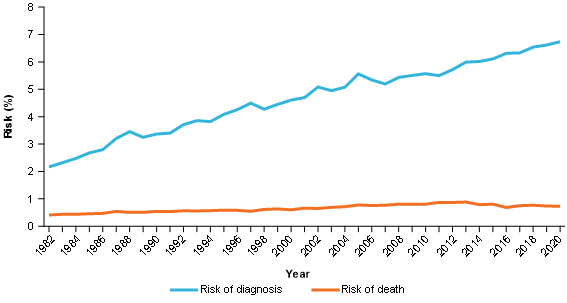
3. epidemiology: why are epidemiological studies used?
Epidemiology: study patterns of disease in population
Helps determine cause, affected populations, guides development of treatment/prevention for hospitals, census, WHO, health practitioners etc results can be applied to large scale population (sanitation) or at risk (breast screening)
Descriptive studies: distribution in relation to age, ethnicity, sex etc
Intervention: evaluate treatment and prevention methods (eg. clinical trials)
analytical studies: determine cause, risk factors & protective factors (observational/case-controlled compare diseased and healthy individuals, are retrospective & experimental compare individuals who are exposed to different risk factors, prospective)
Factors to improve validity: large sample size, variety of backgrounds, control group, conducted over long period of time
4. prevention: how can non-infectious diseases be prevented?
Educational Programs & Campaigns
Carried out by all levels of government, private organisations & health professionals. Aim to educate about risk factors.
Legislation: minimise risk factors, particularly those that are addictive. eg. Tobacco Plain Packaging Act 2011 all tobacco must display educational warnings and graphic imagery. bans on underage drinking etc
Screening Programs: Not educational campaigns but used in conjunction with campaigns!!! eg. A Gift For Life bowel screening kits + media
Paid Advertising: TV/radio/internet-based advertising eg. Slip! Slop! Slap! TV ads. key role in changing sun protection attitudes cases of melanoma in young people fell 5 per cent each year from the mid-1990s to 2010. launched 1981
School Based Education: programs delivered in schools, universities, worksites eg. NSW PDHPE curriculum education around alcohol, tobacco & other drugs
Genetic Engineering
Direct manipulation of an organism’s genome
Pre-Implantation Genetic Testing: IVF → 8 cell stage → singles cell removed and tested for certain genetic diseases (cystic fibrosis, Huntington’s disease, thalassaemia and muscular dystrophy). affected embryos discarded therefore highly affected
Mitochondrial Replacement Therapy: singular circular piece of genetic information, 37 genes, vital for apoptosis & energy within the cell. one mode of MRT involves placing mother genetic information in donor oocyte then fertilising. prevent diseases such as MELAS
Biofortification: increases nutritional value eg. golden rice rice contain genes from maize & soil bacterium, allows beta-carotene production, precursor to vitamin A. 1/4 to 1/2 million children suffer vitamin A related blindness.
Vaccines to prevent cancer: Human Papilloma virus linked to majority of cervical cancer & some other cancer cases. When administered pre-pubescently almost 100% effective in preventing infection
5. technologies and disorders: how can technologies be used to assist people who experience disorders?
EAR
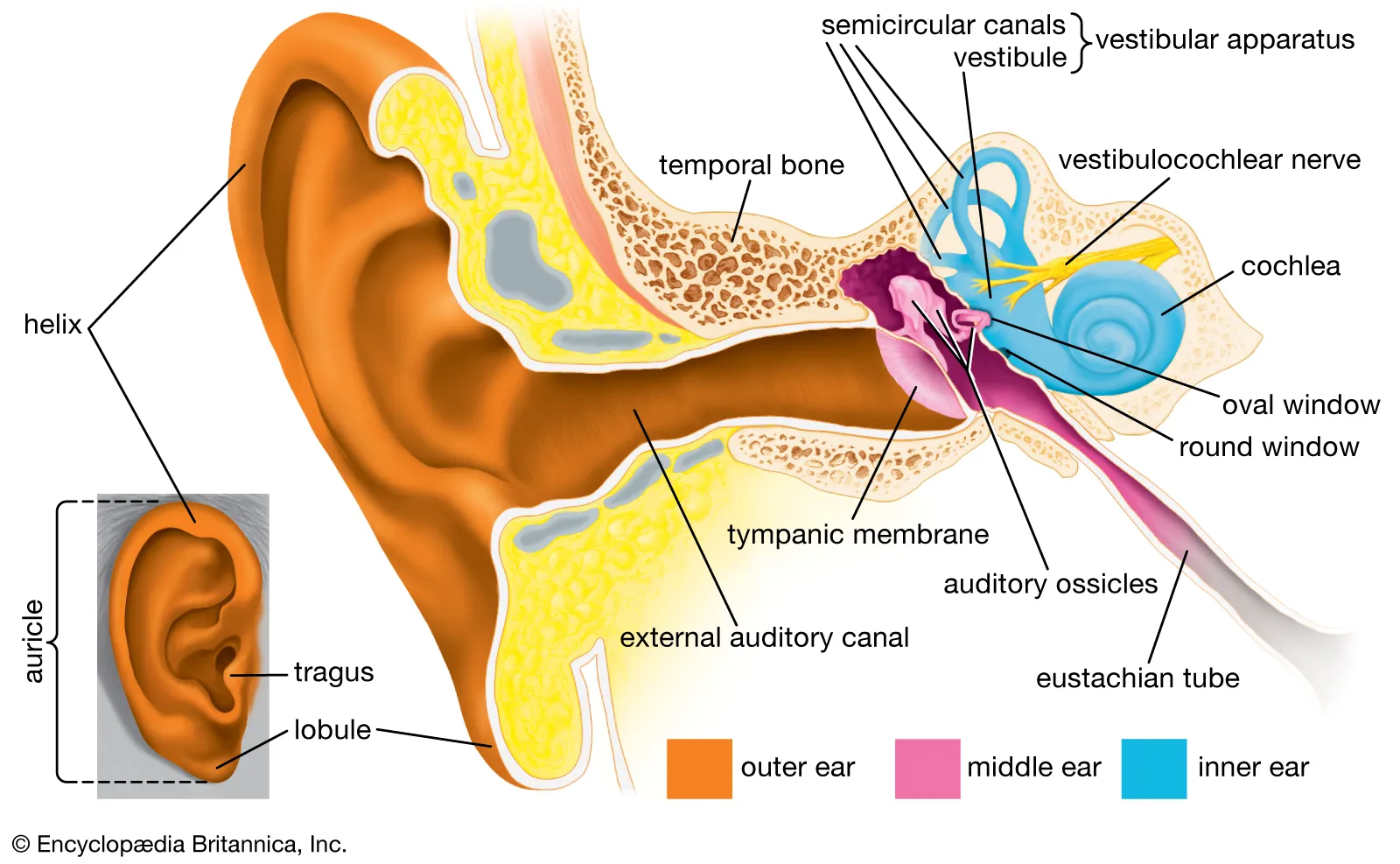
Structure | Description | Function |
|---|---|---|
pinna | fleshy external ear | collect sound, channel into ear |
tympanic membrane (ear drum) | membrane stretched across ear canal | vibrate from sound waves, transfer mechanical energy to middle ear |
ear ossicles | 3 tiny bones link middle ear to cochlea. malleus (hammer), incus (anvil) and stapes (stirrup) | amplify vibration from tympanic membrane, pass on to cochlear fluid |
oval window | membrane between middle ear and cochlea | vibrates to cause movement of fluid in cochlea |
cochlea | spiral shaped fluid filled bone | receives sound in form of vibrations, causes stereo cillia to move |
round window | circular fluid filled chamber | bulges outward to allow pressure changes between middle ear and cochlea |
organ of corti | spiral structure of epithelial cells within the cochlea | contain stereocillia that transfer vibrations into electrochemical signals |
auditory nerve | nerve that travels from ear to the brain | transmits electrochemical signals to brain |
 Hearing Loss
Hearing Loss
Conductive Hearing Loss: issues with mechanical conduction of vibrations throughout outer and middle ear eg. perforated ear drum, infection, hardening of stapes bone, exposure to sudden loud noises, malformation. generally affects volume of noise. assisted by hearing aid & bone conduction implants
Sensorineural Hearing Loss: damage to inner ear including cochlea, hair cells or auditory nerve. usually permanent, affecting volume & clarity. caused by noise exposure, heredity, birth defects, infections, tumours, medication and aging. assisted by cochkear impants.
EYE
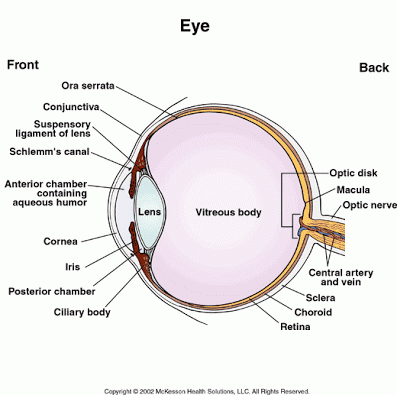
Structure | Description | Function |
|---|---|---|
conjunctiva | mucous membrane that covers eye | protects & keeps eye moist |
cornea | transparent window covering front part of the eye | refracts light to produce sharp image on retina, protects eye |
sclera | tough outer coating (white part of the eye) | protects |
choroid | dark pigment layer containing many blood vessels | absorbs and prevent light scattering causing false images on retina |
retina | inner layer of eye, contains photoreceptors | rods: contain rhodopsin pigment, sensitive to low levels of light, responsible for night vision, contrasts, movement, peripheral vision cones: three types of pigment, each detect different wavelength (colour) of light. responsible for colour |
iris | coloured part of eye. contains muscle | controls amount of light entering eye by adjusting size of the pupil |
pupil | opening in centre of iris | regulates amount of light that enters eye |
lens | transparent protein disk behind the pupil | focuses light into retina |
aqueous chamber | watery liquid between cornea and lens | keeps eyeball spherical, refracts light. contains immunoglobulins |
vitreous humour | gel-like substance between lens and retina | holds retina in place, maintains shape of eyes |
ciliary body | attaches to sensory ligaments | adjust/hold lens in place |
optic nerve | neurons from back of eye to brain | transmit electrical impulses from retina to brain |
accommodation: lens must adjust curvature to refract light correctly for distant/close objects. for distant objects ciliary muscles relax, draw sclera back, flatten lens = less refraction of light. vice versa for close
myopia (short sighted): distant objects are focussed too far forward = blurred. due to elongated eyebal, inadequate refractory power of cornea, lens not flatten enough when cilliary muscles contract. can occur as a result of being in confined space
hyperopia (long sighted): light is focussed too far back, sometimes overcome by accommodation. due to rounded/short eyeball, lens too flat (eg. loss of elasticity old age), refractive power too great for shape of eye
Assistive Technologies:
Laser Surgery: reshape surface of eyes for better refraction eg. myopia, hyperopia, astigmatism (cornea curved more in one direction than other)
Cataract Surgery: natural clouding/yellowing of lens generally due to old age. ultrasound break up lens, fragments removed via suction. clear artificial lens in place
Bionic Eye: camera in glasses gathers data, sends directly to processing centres in brain, bypass rods & cones
KIDNEY
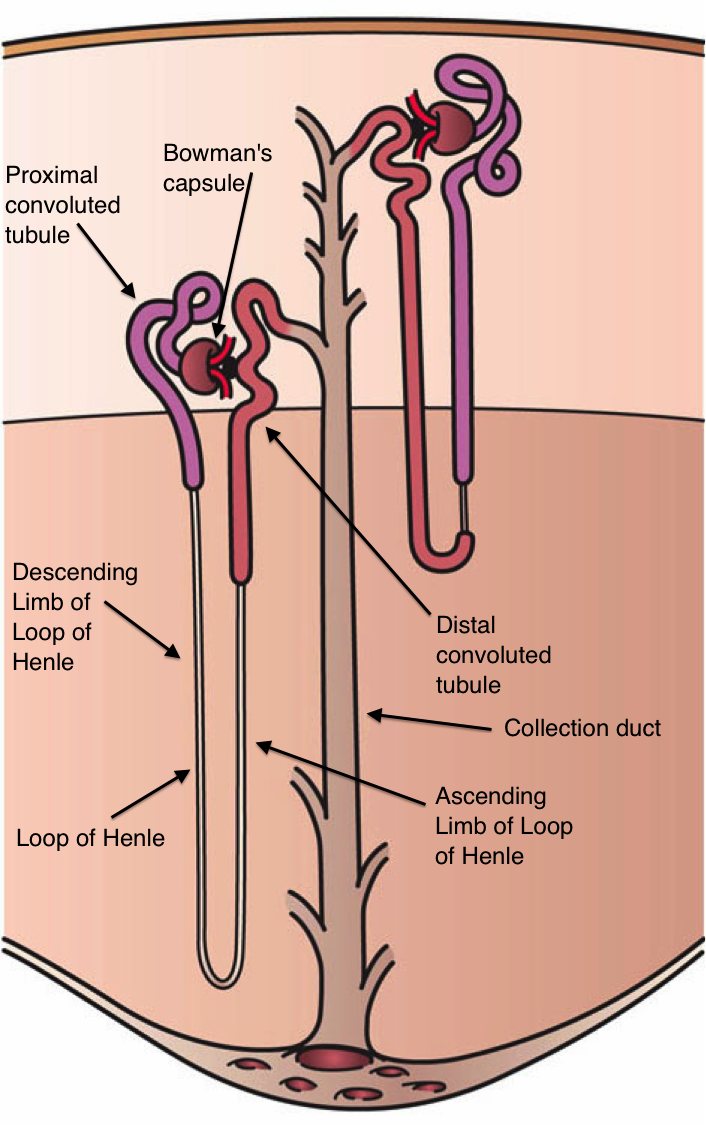
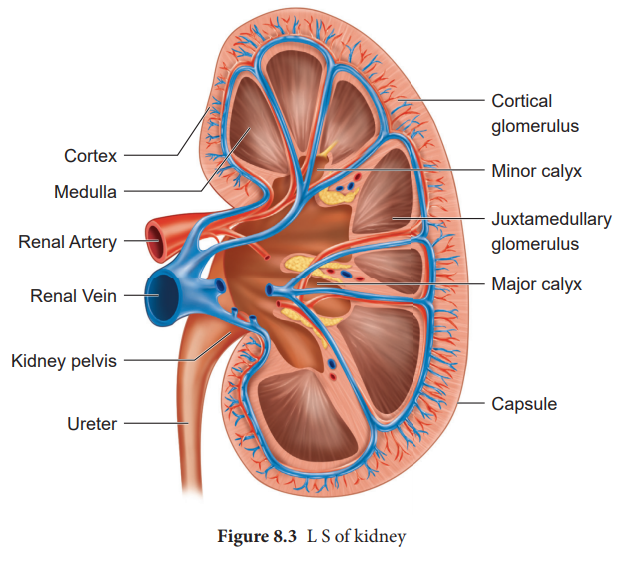
Structure | Description | Function |
|---|---|---|
Renal Artery | artery | carries blood into the kidneys |
renal vein | vein | carries filtered blood out of kidneys to the heart |
kidneys | 2 bean shaped organs below rib cage, left and right of spine | osmoregulation, blood pH, concentration of ions and removal of waste |
ureter | collecting ducts join to form this tube | carries urine to bladder |
bladder | bag like structure | stores urine temporarily |
urethra | tube leading from bladder to outside the body | excretes urine |
cortex | outer part of the kidney | contains glomerulus, Bowman’s capsule and convoluted tubules |
medulla | innermost part of kidney, divided into renal pyramids | contains loop of Henle of each nephron |
renal pelvis | basin-like part of the ureter in the kidney | funnel for urine flowing to ureter |
nephron | each kidney made up of one million | functional unit of the kidney |
glomerulus | networks of capillaries enclosed in the Bowman’s capsule | blood enters under high pressure, causes diffusion by passive filtration |
Bowman’s capsule | cup-like sack at beginning of tubular component of nephron | captures filtrate from glomerulus (similar to blood but no blood cells or large plasma proteins) |
proximal convoluted tubule | segment of nephron that leads from the proximal convoluted tubule to the distal convoluted tubule | selective reabsorption eg glucose, salts, water |
loop of henle | long looped structure in medulla pyramids | osmoregulation |
distal consulted tubule | section of nephron between henle and collecting duct | selective reabsorption |
collecting duct | final portion of nephron | excretion of urine |
PROCCESS
Filtration: under high pressure blood forced through glomerulus (inside bowman’s capsule).All substances small enough will pass through walls of glomerulus eg. nitrogenous waste, water, ions etc. This becomes glomerular filtrate, rest remains blood
Reabsorption: returns essential components (sodium, potassium, chloride, calcium, hydrogen bicarbonate) reabsorbed by active transport and facilitated diffusion. solutes reabsorbed into medulla = water follows because osmosis = reabsorption of water
Secretion: contributes to urine formation. toxic substances removed. metabolic wastes eg. urea and ammonia (diffusion), drugs, hydrogen (active transport)
Removal: urine collects in pelvis of kidney before moving through ureters to bladder, then excreted
Hormonal Regulation
ADH/vassopressin: released if there is water loss eg sweating and blood is more concentrated. increases permeability of collecting duct, more water reabsorbed, urine more concentrated
aldosterone: if salt needs to be conserved eg. bleeding or diarrhoea, released by adrenal gland. increases permeability of distal convoluted tubules = increased reabsorption of sodium = increased absorption of water, decreased potassium= concentrated urine
Loss of Kidney Function
Many can survive with only one kidney. however severe loss of functioning can result in chronic kidney disease
Chronic kidney disease: results in build up of excess waste in bloodstream. Due to exposure to toxic chemicals, birth defects, kidney stones, infection, reduced blood flow, medication, artery problem (eg. high blood pressure). results in loss of function over time
Acute kidney failure: causes rapid loss of kidney function. decreased blood flow (eg. serious injury, burn, dehydration, surgery, septic shock) rapid decline in kidney function. autoimmune disease, urinary tract blockages, pregnancy and clots can also be factores
Dialysis
Treatment that substitutes for function of normal kidneys, instituted when 85-90% of functioning is lost. removes metabolic eastes, excess water and sodium. extends life expectancy 5-10 years
Haemodialysis: blood removed via vein → pumped through thousands of tiny hollow synthetic fibers (semipermeable membrane) → blood flows between fibers, dialysis solution around outside of fibres, water & wastes move between → cleansed blood returned to body
Peritoneal Dialysis: catheter placed into abdominal cavity → dialysate washes around intestines → peritoneal membrane acts as a filter between fluid and bloodstream → different types of solutions allow removal of different types of wastes
 Knowt
Knowt
